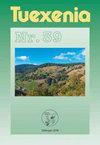黑山北部(Mt. Bjelasica)混交林的多样性和生态分异——以欧洲分类为参照
IF 1.1
4区 生物学
Q3 PLANT SCIENCES
引用次数: 0
摘要
森林的现状以及林分中的树种组成是过去发展的结果,在某种程度上是以前所有影响的记录。作为更好地预测未来森林发展和制定可持续管理战略的基础,我们应该认识到森林的发展进程并了解其驱动因素。黑山的混合山林环境条件变化特别大,为研究靠近其南部分布界限的东地中海混合山林提供了极好的机会。本研究的目的是:1)对东地中海地区山林的区系特征进行研究;2)评估其作为森林类型决定因素的地理位置特征。研究基于黑山东北部比耶拉西卡山境内158个采样点收集的数据。采用数值排序和分类方法,评价了地形、气候和地理立地特征对植被分异和森林类型形成的影响。根据区系组成划分出3种类型的山林林,其树层组成可以很容易地描述为:1)云杉、银杉和山毛榉混交林,2)过度开发造成的单优势山毛榉林,3)先锋种(松、白杨、桦木)和欧洲蛇麻混交林。讨论了这些类型的物理站点特征,并将其置于欧洲背景下。黑山的山林与欧洲其他地区的森林非常相似,可以被纳入现有的“欧洲山毛榉林分类”(WILLNER et al. 2017)和WILLNER & GRABHERR(2007)。本文章由计算机程序翻译,如有差异,请以英文原文为准。
Diversity and ecological differentiation of mixed forest in northern Montenegro (Mt. Bjelasica) with reference to European classification
The current state of forests as well as tree species composition in stands is the result of past development and somehow a record of all previous influences. As a base for better projections of future forest development and the development of sustainable management strategies we should recognize developmental processes in forests and understand their drivers. Mixed mountain forests in Montenegro, with an exceptionally large variation of environmental conditions, provide an excellent opportunity to study eastern-Mediterranean mixed mountain forests near their southern distribution limit. The goals of this study were 1) to floristically characterize mountain forests in an Eastern Mediterranean region and 2) to assess their physical site properties as determinants of forest types. Research was based on data collected from 158 sampling plots in the territory of the mountain Bjelasica, north-east Montenegro. The influence of topographic, climatic and edaphic site characteristics on the differentiation of vegetation and formation of forest types was assessed using numerical ordination and classification. Three types of mountain forests were separated based on their floristic composition, which can be easily characterized by the composition of their tree layer: 1) Mixed forests with spruce, silver fir and beech, 2) monodominant beech forests resulting from over-exploitation of type 1, and 3) heliophytic mixed forests with pioneer species (pine, aspen and birch) and European hop-hornbeam. The types are discussed regarding their physical site characteristics and put in a European context. Mountain forests of Montenegro are quite similar to forests in other regions of Europe and can be arranged into the existing “Classification of European beech forests” (WILLNER et al. 2017) and according to WILLNER & GRABHERR (2007).
求助全文
通过发布文献求助,成功后即可免费获取论文全文。
去求助
来源期刊

Tuexenia
PLANT SCIENCES-
CiteScore
2.80
自引率
25.00%
发文量
0
期刊介绍:
Tuexenia publiziert Original- und Übersichtsarbeiten sowie Berichte zu Themen der Geobotanik / Vegetationsökologie und zu Nachbarwissenschaften wie Populationsökologie, Biodiversitätsforschung, Biozönologie, Renaturierungsökologie und ihren Anwendungen, vor allem im Naturschutz. Der geografische Schwerpunkt liegt in Zentraleuropa und angrenzenden Regionen.Tuexenia erscheint jährlich in einem Band, der etwa zur Jahresmitte fertig gestellt wird. Autoren erhalten von jeder Arbeit eine PDF-Datei und gemeinsam 20 Sonderdrucke kostenlos.
Die Qualität der wissenschaftlichen Manuskripte wird durch die Redaktion und einen Wissenschaftlichen Beirat (Peer Review) gesichert (s. auch die Manuskript-Richtlinien vor dieser Seite). Es werden keine Druckkosten erhoben. Tuexenia legt Wert auf allgemeine Online-Verfügbarkeit der Beiträge.
 求助内容:
求助内容: 应助结果提醒方式:
应助结果提醒方式:


